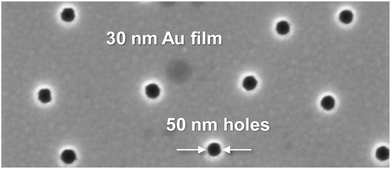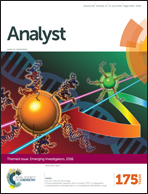Biosensing using plasmonic nanohole arrays with small, homogenous and tunable aperture diameters†
Abstract
Plasmonic nanohole arrays are widely used for optical label-free molecular detection. An important factor for many applications is the diameter of the apertures. So far nanohole arrays with controllable diameters below 100 nm have not been demonstrated and it has not been systematically investigated how the diameter influences the optical properties. In this work we fine-tune the diameter in short range ordered nanohole arrays down to 50 nm. The experimental far field spectra show how the wavelength of maximum extinction remains unaffected while the transmission maximum blue shifts with smaller diameters. The near field is visualized by numerical simulations, showing a homogenous enhancement throughout the cylindrical void at the transmission maximum for diameters between 50 and 100 nm. For diameters below 50 nm plasmon excitation is no longer possible experimentally or by simulations. Further, we investigate the refractive index sensing capabilities of the smaller holes. As the diameter was reduced, the sensitivity in terms of resonance shift with bulk liquid refractive index was found to be unaltered. However, for the transmission maximum the sensitivity becomes more strongly localized to the hole interior. By directing molecular binding to the bottom of the holes we demonstrate how smaller holes enhance the sensitivity in terms of signal per molecule. A real-time detection limit well below one protein per nanohole is demonstrated. The smaller plasmonic nanoholes should be suitable for studies of molecules confined in small volumes and as mimics of biological nanopores.

- This article is part of the themed collection: Emerging Investigators

 Please wait while we load your content...
Please wait while we load your content...